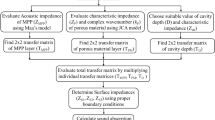Abstract
With the continuous advancement of networks, communication technology, sensor technology, artificial intelligence and other technologies, the field of intelligent industry is booming. As the leader of emerging technologies, digital twin technology has also become the new direction for the next generation of industrial intelligence. Based on the digital twin technology, kapok fiber and mixed fiber nonwoollen materials were designed at different positions of the microperforation, and a composite sound absorbing material with light weight, simple structure and low cost was developed to improve the sound absorption performance of the composite sound absorbing material. Also, based on the transfer matrix method, a sound absorption model of EPDM-based textile structural composite is proposed. The sound absorption coefficient of the composite sound absorber predicted by the transfer matrix model is completely consistent with the experimental test value. The model can be applied to predict and analyze the sound absorption characteristics of EPDM-based textile composite panel structural materials. This work can provide a theoretical basis and application for the structural design of the perforated plate and the porous non-woven material composite sound absorber.








Similar content being viewed by others
Data availability
The data used to support the findings of this study are available from the corresponding author upon request.
Change history
02 April 2024
This article has been retracted. Please see the Retraction Notice for more detail: https://doi.org/10.1007/s10878-024-01150-w
References
Champoux Y, Stinson MR (1992) On acoustical models for sound propagation in rigid frame porous materials and the influence of shape factors. J Acoust Soc Am 92:1120–1131
Duval A, Rondeau J-F, Deshayes G, Lhuillier F, Bischoff L, Teyssandier B (2006) Generalizes light-weight concept: a comprehensive acoustic package weight reduction strategy. Autom Comfort Conf 11(3):15–16
Garai M, Pompoli F (2005) A simple empirical model of polyester fiber materials for acoustical application. Appl Acoust 66:1383–1398
Guo W, Xiong N et al (2011) Design and analysis of self-adapted task scheduling strategies in wireless sensor networks. Sensors 11(7):6533–6554
Ingard U (1948) On the radiation of sound into a circular tube with an application to resonators. J Acoust Soc Am 20(5):665–682
Jiang Y, Tong G et al (2019) A pedestrian detection method based on genetic algorithm for optimize XGBoost training parameters. IEEE Access 7:118310–118321
Kang J, Fuchs HV (1999) Predicting the absorption of open weave textiles and micro-perforated membranes backed by an air cavity. J Sound Vib 220(5):905–920
Kino T et al (2007) Experimental determination of the microphone and macrostructure parameters influenceing the acoustical performance of fiberous media. Appl Acoust 68:1439–1458
Lee YY, Lee EWM (2007) Widening the sound absorption bandwidths of flexible micro-perforated curved absorbers using structural and acoustics resonances. Int J Mech Sci 49:925–934
Lissek H, Boulandet R, Fleury R (2011) Electroacoustic absorbers:bridging the gap between shunt loudspeakers and active soundabsorption. J Acoust Soc Am129(5):2968–2978
Lu Y, Wu S et al (2017) Exploring finger vein based personal authentication for secure IoT. Future Gener Comput Syst 77:149–160
Maa DY (1998) Potential of microperforated panel absorber. Acoust Soc Am 104(5):2861–2866
Maa DY (1998) Potential of micro-perforated panel absorber. J Acoust Soc Am 1049(12):2861–2866
Mejdi A, Atalla N (2012) Vibroacoustic analysisof laminated com-posite panels stiffened by complex laminated composite stiff-eners. Int J Mech Sciences58(6):13–26
Merve K, Yasemin K (2012) The effect of physical parameters on sound absorption properties of natural fiber mixed nonwoven composites. Text Res J 82(20):2043–2053
Sun FG, Chen HL, Wu JH, Feng K (2010) Sound absorbing character wastics of fibrous metal materials at high temperatures. Appl Acoust 71(4):221–235
Wang X, Li Q et al (2008) Ant colony optimization-based location-aware routing for wireless sensor networks. Int Conf Wirel Algorithms Syst Appl 12(1):613–624
Wan R, Xiong N (2018) An energy-efficient sleep scheduling mechanism with similarity measure for wireless sensor networks. Human-centric Comput Inform Sci 8(1):1–22
Wan F, Zhu F (2014) Effectsofcarbon black (CB) and alumina oxide on the electromagnetic- and microwave-absorption properties of SiC fiber/aluminum phosphate matrix composites. Ceram Int 40(4):15849–15857
Xia F, Hao R et al (2013) Adaptive GTS allocation in IEEE 802.15.4 for real-time wireless sensor networks. J Syst Archit 59(10):1231–1242
Yang C, Cheng L, Pan J (2013) Absorption of oblique incidence sound by a finite micro-perforated panel absorber. J Acoust Soc Am 133(6):201–209
Yang G, Yang Q, Jin H (2021) A novel trust recommendation model for mobile social network based on user motivation. Electron Commer Res 21(3):809–830
Zhen N, Li FL, Wang YS et al (2012) Bandgap calculationfor mixed in-plane waves in 2D phononic crystals based ondirichlet-to-Neumann map. Acta Mech Sin 28(3):1143–1153
Acknowledgements
The work was supported by Shang Hai Guang Jiao Chemical Industry in China and Ping Xiang Xin Tao Chemical Industry, Jiang Xi, China.
Funding
Project supported by Provincial Natural Science Foundation of Hunan (2020JJ4245).
Author information
Authors and Affiliations
Corresponding author
Ethics declarations
Conflict of interest
The authors declare that they have no known competing financial interests or personal relationships that could have appeared to influence the work reported in this peper.
Additional information
Publisher’s Note
Springer Nature remains neutral with regard to jurisdictional claims in published maps and institutional affiliations.
This article has been retracted. Please see the retraction notice for more detail:https://doi.org/10.1007/s10878-024-01150-w
Rights and permissions
Springer Nature or its licensor (e.g. a society or other partner) holds exclusive rights to this article under a publishing agreement with the author(s) or other rightsholder(s); author self-archiving of the accepted manuscript version of this article is solely governed by the terms of such publishing agreement and applicable law.
About this article
Cite this article
Wang, K., Wang, W. RETRACTED ARTICLE: Sound absorption performance of EPDM-based textile composites investigated through the transfer matrix model. J Comb Optim 45, 33 (2023). https://doi.org/10.1007/s10878-022-00957-9
Accepted:
Published:
DOI: https://doi.org/10.1007/s10878-022-00957-9




